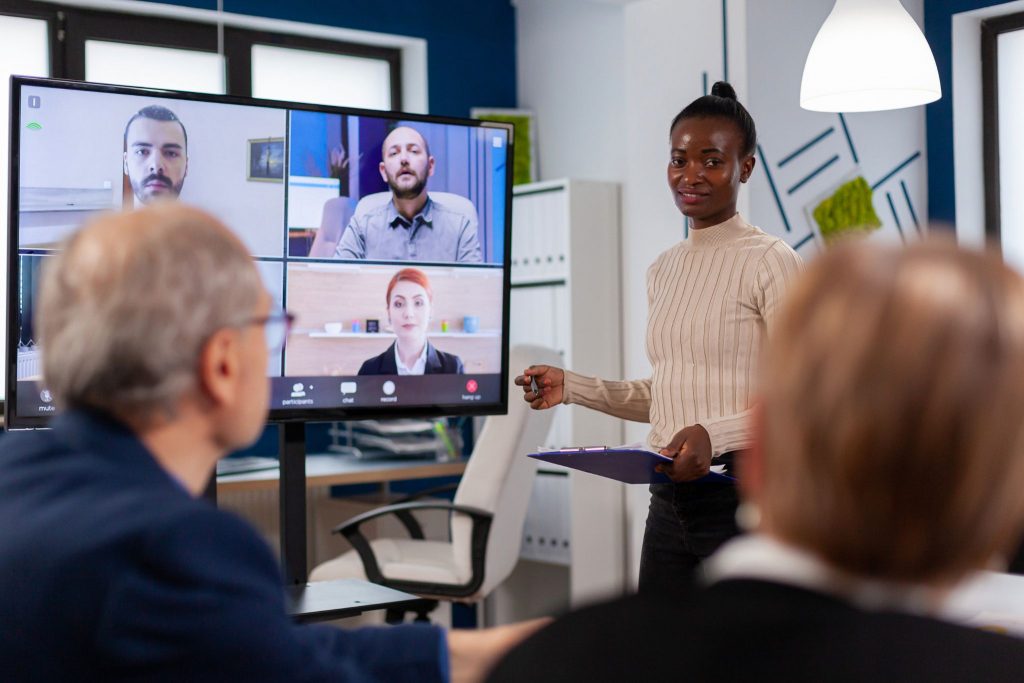As staff continue to work in remote locations while others return to in-person workspaces, the approach to learning needs to accommodate a hybrid environment. If planned intentionally and with the use of a variety of technology resources, organizations can continue to deliver engaging and inclusive learning opportunities through hybrid learning.
What is Hybrid learning all about?
Hybrid learning isn’t just about moving some lessons online. It’s a smart way to mix the benefits of in-person and online learning for a better educational experience
Planning intentionally for a hybrid learning opportunity means planning for three environments: in-person, online, and the space in between where online and in-person meet. Planning intentionally with facilitators and moderators in each environment is critical. There are times where in-person and online attendees need different accommodations and activities, and each needs a dedicated facilitator in their respective environments.
The third space is where you actively bring all facilitators and attendees together for well-designed presentations and activities that are functional in both spaces. For example, presentations and modified activities can be synchronous with an in-person presenter speaking to both audiences. Meanwhile, some activities might not work well in both environments, so you’d split the in-person and online groups into their own spaces to learn through different types of activities that work well for each environment. Similarly, at a full-day learning event a break or lunch will be very different in-person.
Online attendees should not be treated as second class citizens having to listen to a cacophony of noise in a room, there can be activities and connections facilitated in their separate online space.
3 tips to unlock hybrid learning
Tip 1: Planning
When creating a hybrid lesson plan, consider these questions:
- What is the ratio of in-person/online participants?
- Where will the experiences be the same – can they be simultaneous?
- Where will the experiences be unique – how will you navigate that?
- What assigned roles will there be for in-room and online:
- Facilitators
- Moderators
- Technical support
- How will you greet the remote people?
- Should there be separate online and in-person ice breakers?
- How will you handle audio challenges
- Which audiences need to be a part of each segment?
- How will you handle breaks?
- How will you manage activities and when do you need them?
- When will activities be different online and in-person?
- How will you use breakout rooms in each environment?
- What technology do you need to help online participants feel included?
Tip 2: Norms
Clear norms are the roadmap to effective and inclusive interactions. For hybrid to work smoothly, rules like only one person talks at a time and no side conversations ensures all participants can hear contributions and avoids chaos. It is also ideal to ensure there is a microphone for in-person attendees to speak into for clear audio and inclusion for online participants.
These norms ensures everyone is respectful and has a chance to share their ideas, making learning together a pleasant experience. Take advantage of the online space and define where and when both audiences will come together to use online chat and hand raising features. Group norms are the unsung heroes, often overlooked yet crucial in building a conducive learning environment, especially in a dynamic hybrid one.
Tip 3: Engagement opportunities
Engagement is not just about being present; it’s about being involved. Research underscores that meetings with higher participation levels are seen as more inclusive. Now, how do we add that spark of engagement?
One simple technique is turning on video during online sessions and ensuring there are various video camera angles in the room to capture in-room participants. Seeing each other fosters a sense of community, making the virtual space more human and interactive. It’s akin to opening the windows and letting the sunlight pour into a room, making the learning experience warm and welcoming.
There are also a variety of collaboration tools that can be used in that “space in between” where both in-person and virtual attendees can simultaneously participate. Surveys before, during, and after help in understanding the rhythm of learner needs and preferences. Encouraging the use of gifs and visuals will make online chat lively making learners feel more connected. Breakout rooms provide an opportunity for small-group discussions. Using digital quiz platforms like Kahoot and just-in-time polling like Mentimeter keep all participants engaged and seeing responses from others.
Additionally, a standout tool is the virtual whiteboard like Mural or Miro, as a canvas for ideas, discussions, and collaborative problem-solving. It’s where the abstract takes a visible form, promoting active engagement.
Summary
Hybrid learning is not a fleeting trend; it’s a paradigm shift, knitting the in-person and online learning threads together. By setting clear meeting norms, enhancing engagement through simple yet impactful techniques, and harnessing collaborative tools, hybrid learning is a step towards a more inclusive and interactive learning realm. Hybrid learning becomes a thrilling adventure when everyone knows what to expect, feels connected, and can work together in each distinct space.

